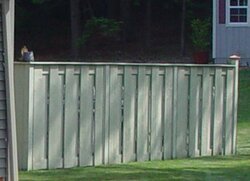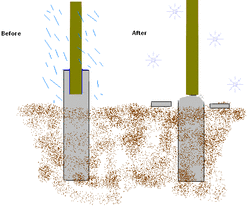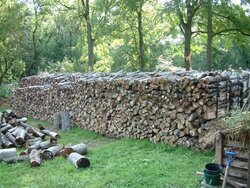Well, within a week or two, I'm fenceing in the backyard to keep 2 small kids in,roaming-lawn-fertilizing dogs out, and the neighbors guessing as to what I'm up to.As of now I plan on doing a 6' high alternating board on board design(no"bad" side)with my 4x4 posts@ 8' centers.What I'm unsure of is the best way to support the 4x4's;I know sauna tubes work well but I thought I might be able to just bore 3'deep holes 5" in diameter then back fill with a quick-drying mortar after dropping the posts in place.Any suggestions?
Privacy Fence
- Thread starter titan
- Start date
-
Active since 1995, Hearth.com is THE place on the internet for free information and advice about wood stoves, pellet stoves and other energy saving equipment.
We strive to provide opinions, articles, discussions and history related to Hearth Products and in a more general sense, energy issues.
We promote the EFFICIENT, RESPONSIBLE, CLEAN and SAFE use of all fuels, whether renewable or fossil.
You are using an out of date browser. It may not display this or other websites correctly.
You should upgrade or use an alternative browser.
You should upgrade or use an alternative browser.
- Status
- Not open for further replies.
wg_bent
Minister of Fire
Titan said:Well, within a week or two, I'm fenceing in the backyard to keep 2 small kids in,roaming-lawn-fertilizing dogs out, and the neighbors guessing as to what I'm up to.As of now I plan on doing a 6' high alternating board on board design(no"bad" side)with my 4x4 posts@ 8' centers.What I'm unsure of is the best way to support the 4x4's;I know suana tubes work well but I thought I might be able to just bore 3'deep holes 5" in diameter then back fill with a quick-drying mortar after dropping the posts in place.Any suggestions?
I just finished a 165' of stockade fencing. This was easy. 5' hole isn't big enough to sink a 4x4. Think about the corner to corner size of a 4x4.
I dug 8" holes with a post hole digger, roughly 2' deep. Put the post in the hole, and make plumb using 2 supports. fill the hole about 1/2 with water and pour in 2 bags of Quikrete, add water as needed. This is actually the directions on the back of the Quikrete bag. Don't use tubes for posts. WAY too much work and probably not as secure for the application.
webbie
Seasoned Moderator
I built my own rear yard fence like that - board on board - and I used cedar (to match the boards) and used a plain post hole digger and the posts are about 2.5 feet in the ground. Cement is not needed if your ground is tight and you tamp around them well, but if you want them to be really solid, put them in, pack about 1 foot of dirt, then pour the rest with concrete (bag mix) - leaving it below ground level so you can cover it with a couple inches of dirt so that the concrete does not show.
I'll dig around and see if I have any pics of our rear fence.
(bad pic, but here it is)
I used all cedar, since it is in contact with ground and I wanted it to last. These are on 6 foot centers cause that worked out for me - I just used these on either end, and then a cheapo picket in the rear - because I only needed the privacy on the ends (woods in rear)
I'll dig around and see if I have any pics of our rear fence.
(bad pic, but here it is)
I used all cedar, since it is in contact with ground and I wanted it to last. These are on 6 foot centers cause that worked out for me - I just used these on either end, and then a cheapo picket in the rear - because I only needed the privacy on the ends (woods in rear)
Attachments
eernest4
New Member
i like the idea of digging 3 ft hole and inserting 4x4 , then 1 ft of dirt to keep it verticle on plum
& then 2 ft of dry cement mix & then water.
But , Im lazy & my yard is full of rocks under the top soil.
so, my answer is to only dig down 18 inches with a 6 inch or 7 inch dia. hole and wedge in some rocks to keep the 4x4 verticle, then either dry cement & then water or mixed cement.
one advantage of only a 18 inch deep hole is its deep enough to hold the pole and leaves you
with a 6 ft 4in upright to attach the roof of a 8x8 shed to, just in case your making a wood shed
out of stockade fencing for walls.
second advantage of an 18 in hole is it dont take so long to dig and your not so tired when its dug .
third advantage is you dont need so much cement.
Anyways, it works for me. I have not had any poles fall down in the 4 years since i installed the first one, despite considerable rain fall.
hey , keep digging 3 ft deep holes, its not my back thats hurting from 2 much digging and im not paying for the extra cement or buying 12 ft long 4x4 at double the price.
But your deep holes are twice as strong, 2 give credit where credit is due.
for me strong enough is good enough because im not biulding a bridge over the missippi river.
& then 2 ft of dry cement mix & then water.
But , Im lazy & my yard is full of rocks under the top soil.
so, my answer is to only dig down 18 inches with a 6 inch or 7 inch dia. hole and wedge in some rocks to keep the 4x4 verticle, then either dry cement & then water or mixed cement.
one advantage of only a 18 inch deep hole is its deep enough to hold the pole and leaves you
with a 6 ft 4in upright to attach the roof of a 8x8 shed to, just in case your making a wood shed
out of stockade fencing for walls.
second advantage of an 18 in hole is it dont take so long to dig and your not so tired when its dug .
third advantage is you dont need so much cement.
Anyways, it works for me. I have not had any poles fall down in the 4 years since i installed the first one, despite considerable rain fall.
hey , keep digging 3 ft deep holes, its not my back thats hurting from 2 much digging and im not paying for the extra cement or buying 12 ft long 4x4 at double the price.
But your deep holes are twice as strong, 2 give credit where credit is due.
for me strong enough is good enough because im not biulding a bridge over the missippi river.

babalu87
New Member
Some of you guys dont know how easy you have it.
I dug out the holes for the posts of my deck and it took forever. I cant stick a piece of re-bar in the ground around here without hitting rocks/boulders. I swear a friggin glacier full of stone went right over my property, I couldnt put up a fence on a bet.
I dug out the holes for the posts of my deck and it took forever. I cant stick a piece of re-bar in the ground around here without hitting rocks/boulders. I swear a friggin glacier full of stone went right over my property, I couldnt put up a fence on a bet.
True enough Bab, I seem to live on bedrock with roughly 6" of soil on top of it.When starting my fence I rented a Hydraulic post hole auger with 6" auger and bored 88 holes to a depth of 3'.Took me 2 days and near killed me,although the machine came out on the worst end of it.The fence looks good though,and it's not going anywhere.....at least that's what I keep telling myself.
Highbeam
Minister of Fire
I set 32 4x4 posts this last weekend to support 200 feet of ranch style horizontal board fence. I rented a post hole auger, the 2 man style that is great for bruising the left legs. It worked pretty well except for when it would grab a rock or deflect off of a rock and drift out of line with the other holes.
I dug out no less than 2 feet deep and no more than 3 feet deep. Place post, plumb it to make sure it is in the right spot and then backfill around the post with dirt to the last one foot, tamp well, plumb again, dump in 80lbs of dry concrete mix, tamp, plumb, and hose everything until wet. Be sure that the concrete is shaped to direct water away from the 4x4 but below grade is fine.
Now I need to place all the 2x6 boards. Thank goodness the lumber market is crashing.
I dug out no less than 2 feet deep and no more than 3 feet deep. Place post, plumb it to make sure it is in the right spot and then backfill around the post with dirt to the last one foot, tamp well, plumb again, dump in 80lbs of dry concrete mix, tamp, plumb, and hose everything until wet. Be sure that the concrete is shaped to direct water away from the 4x4 but below grade is fine.
Now I need to place all the 2x6 boards. Thank goodness the lumber market is crashing.
thephotohound
New Member
Maybe this is just my inexperience talking, but why arent you mixing the concrete before pouring it? How can you be sure you've got the right amount of water? I always thought concrete was more of an exact science than that.
Re: an earth auger, I have a Jiffy ice drill that I plan to get an 8" earth bit for. Anyone have any experience with this?
Re: an earth auger, I have a Jiffy ice drill that I plan to get an 8" earth bit for. Anyone have any experience with this?
Photo,I used Quickrete in my post holes,it's pre-mixed-you just hit it with "enough" water then rod it with a stick .Not exact like good concrete but it sets fast and just as hard.....I won't mix cement again,this stuff was much easier.
Rhone
Minister of Fire
- Nov 21, 2005
- 827
This reminds me of a problem I experienced from the previous homeowners. They put pouring tubes in the ground, put wooden 4x4 support posts into the tubes and poured the cement around these wooden supports so they were encased into the cement. I'm sure they were thinking saves them from having to go through the work & cost of anchor plates & threaded rod plus saves concrete. That technique is actually advertised and allowed for support structures, I think it shouldn't.
Anyway when the pour happened the wood posts absorbed the water from the cement and expanded, the cement set, the posts dried and shrunk leaving a gap all the way around them which filled with water when it rained, winter came it froze and blew apart the cement around the support posts leaving them bare and nothing to prevent shifting. I included a picture of what I'm talking about that happened to all the footers of the supports of my back porch.
So, the technique is good for a fence since it's not a support structure and if it splits the cement, not like it has anywhere to go. But, figured I'd show the problem this technique can cause for anyone thinking of adding a support structure and using this approach, which unfortunately is often stated as an option.
Anyway when the pour happened the wood posts absorbed the water from the cement and expanded, the cement set, the posts dried and shrunk leaving a gap all the way around them which filled with water when it rained, winter came it froze and blew apart the cement around the support posts leaving them bare and nothing to prevent shifting. I included a picture of what I'm talking about that happened to all the footers of the supports of my back porch.
So, the technique is good for a fence since it's not a support structure and if it splits the cement, not like it has anywhere to go. But, figured I'd show the problem this technique can cause for anyone thinking of adding a support structure and using this approach, which unfortunately is often stated as an option.
Attachments
Eric Johnson
Mod Emeritus
thephotohound
New Member
Titan said:Photo,I used Quickrete in my post holes,it's pre-mixed-you just hit it with "enough" water then rod it with a stick .Not exact like good concrete but it sets fast and just as hard.....I won't mix cement again,this stuff was much easier.
By "pre-mixed" I assume you mean just the aggregate and dry cement are dry-mixed? I still can't find anywhere on the bag where it tells you to mix it all in the hole (just happened to go to HD at lunch). I'm not doubting that it works, I'm just making sure it's the most effective way. I'm always looking to save time and chiropractor co-pays if I can!
Highbeam
Minister of Fire
Remember the purpose of concrete around a post, mainly to fill in the hole around the post tightly and to set up at least as firmly as the surrounding soil to prevent movement. There's no support function or even structural function other than that you want the concrete to stay firm and you want water to be able to get away from the wood. Mixing concrete properly will get stronger concrete but in my ground there is always sufficient moisture to allow a cure over time. It will actually set up and be almost impossible to tell the difference between dry set and mixed concrete. Maybe never as strong but that isn't really an issue.
Highbeam
Minister of Fire
Oh and the professional fence guys taught me to just dump it in dry. They didn't even hose it, but depended on ground moisture. Seems to work.
thephotohound
New Member
I stand corrected. I think where I was lost was the (lack of a) load bearing structural component. I wasn't thinking that there wouldn't be a load on it.
zzr7ky
Minister of Fire
- Jun 12, 2006
- 1,053
Hi -
My 400' of board fence like you describe is standing tall after 15+ years...
Some deckbuilding types told me to just drill the holes to accept the posts, fill with a little pea gravel, perform any minor adjustements, then fill near top with more pea stone.... It worked well for me.
I'm have clay, sand, and loam in varios spots along the fence. Pea stone was cheap enough and easy to handle.
Re-doing some footings on my deck I set posts the same way and they are also performing well. The psots in cement were actually in worse shape up near the top of the concrete.
Goodluck!
Mike P
My 400' of board fence like you describe is standing tall after 15+ years...
Some deckbuilding types told me to just drill the holes to accept the posts, fill with a little pea gravel, perform any minor adjustements, then fill near top with more pea stone.... It worked well for me.
I'm have clay, sand, and loam in varios spots along the fence. Pea stone was cheap enough and easy to handle.
Re-doing some footings on my deck I set posts the same way and they are also performing well. The psots in cement were actually in worse shape up near the top of the concrete.
Goodluck!
Mike P
jqgs214
Minister of Fire
My 100+ feet of fence just dug the holes plopped em in and back filled. Been that way for 3 years and no visible movement.
- Status
- Not open for further replies.
Similar threads
- Replies
- 25
- Views
- 7K
- Replies
- 18
- Views
- 5K
- Replies
- 0
- Views
- 7K




